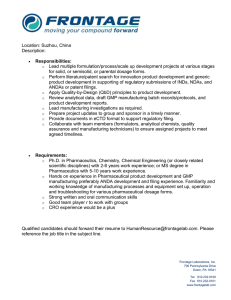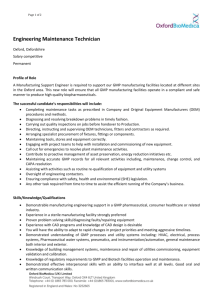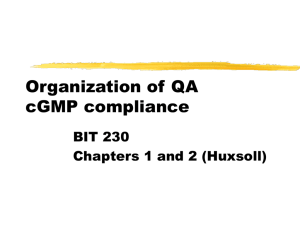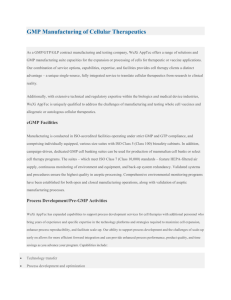Seminar on PLANT DESIGN
advertisement
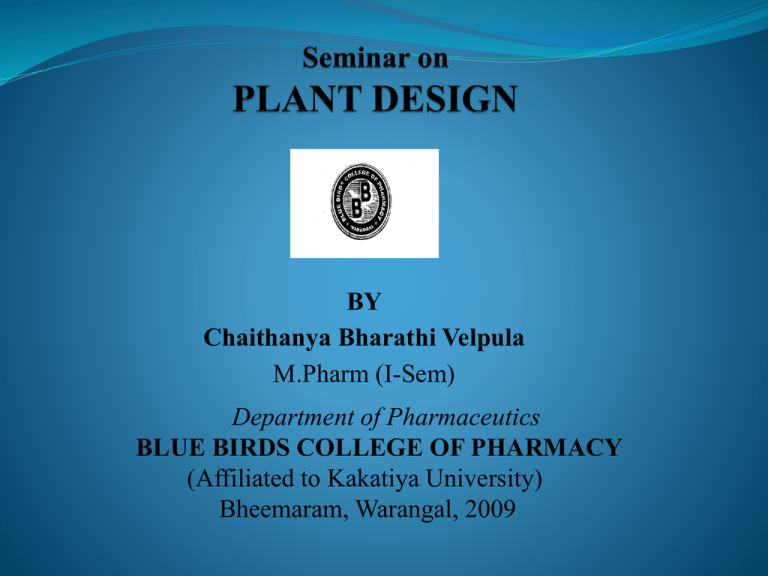
BY Chaithanya Bharathi Velpula M.Pharm (I-Sem) Department of Pharmaceutics BLUE BIRDS COLLEGE OF PHARMACY (Affiliated to Kakatiya University) Bheemaram, Warangal, 2009 CONTENTS Introduction Plant Layout GMP in Solid dosage forms GMP in Topical products GMP in Liquid Orals GMP in Parenterals GMP in metered dose inhalers Conclusion References Introduction A plant is a place where Men, Material, Method , Money and Machinery are brought together for manufacturing of a product. Good Manufacturing Practices (GMP ) : GMP is that a part of Quality assurance which ensures that the products are consistently manufactured and controlled to the Quality standards appropriate to their intended use and as required by the marketing authorization. cGMP : Where c = current ( to emphasize that expectations are dynamic ). Importance of GMP : A poor quality medicine may contain toxic substance that have been unintentionally added . A medicine that contains little or none of the claimed ingredient will not have the intended therapeutic effect. GMP is aimed primarily at diminishing the risks inherent in any pharmaceutical production, which may broadly be categorized in two groups : cross contamination/mix-ups false labelling. GMP : Starting materials Premises Equipment Training Personal hygiene of staff Details and written procedures (which are essential for the quality of finished product). Plant Layout Plant layout is a coordinated effort to achieve integrate machines materials and personnel for economic production. Lay outs are of two types: a) Process layout or functional layout : All the machines of a particular class doing particular type of work or process are arranged in a separate department. b) Product layout or straight line layout : In this type all the machinery doing various operations are arranged in a line. Pharmaceutical Plant Layout BUILDING FINISHES Chemical Weighing : A central weighing department Sinks and drains Balances and scales Meters to provide supervision, proper weighing equipment , dust collection and adequate sanitation. to avoid even minimal cross-contamination . WEIGHING Product Flow Diagram RAW MAT. RECEIPT PACK. MAT. RECEIPT Wood free zone DISPENSARY PACK. MAT STORE MANUFACTURING GMP ZONE PRIMARY PACKING PRIMARY PACK MAT. CLEAN DOWN SECONDARY PACKING DISPATCH GMP IN SOLID DOSAGE FORMS TABLETS The tablet production department shall be divided in to three distinct and separate sections as follows: 1.Granulation section. 2.Tablet compression section. 3.Coating section. 1. Granulation Section : The numerous steps in granulating procedures increase the possibility of cross-contamination , in-correct product identification and or mix-ups. To eliminate these possibilities, a separate room or booth is recommended for each step. A washing facility should be provided for cleaning of portable equipment such as granulators and mills. And to facilitate cleaning of non-portable equipments such as fluid-bed driers and mixers, each room should provided with floor drains. The aforementioned precautions are equally applicable to manufacturing of powders and bulk materials for capsule filling. 2. Tablet Compressing Section : Separate rooms for tablet machines is necessary step to avoid cross contamination. The booth or room walls should be extended from floor to ceiling and made up of tiles. Space should also be provided for in-process testing of equipment such as balances and tablet hardness testers. Suitable physical, procedural and labelling arrangements shall be made to prevent mix up of materials, granules and tables on compression machinery. Tablets shall be de-dusted, preferably by automatic device and shall be monitored for the presence of foreign materials. Accurate and calibrated weighting equipment shall be readily available and used for in-process monitoring of tablet weight variation. 3. Coating Section Air supplied to coating pans for drying purposes shall be filtered air and of suitable quality. Coating solutions and suspensions shall be made afresh and used in a manner, which shall minimize the risk of microbial growth. Enclosing pans in groups have advantage to muffle the noise level to acceptable limits. The noise level can also be reduced in open pans by the use of insulating material around the outside of coating pans. CAPSULES For the manufacture of capsules, o A separate enclosed areas o Suitably air-conditioned o Dehumidified o An airlock arrangement Empty capsules shall be stored under conditions which shall ensure their safety from the effects of excessive heat and moisture. Edible grade colours and suitable printing ink shall be used for such printing. GMP IN TOPICAL PRODUCTS Semi solid dosage forms include creams, ointments, lotions. The manufacturing facilities for these dosage forms are as follows : • The entrance to the area where these products are manufactured should be through a suitable airlock. • The area shall be fitted with an exhaust system of suitable capacity to effectively remove vapours, fumes, floating dust particles. • The equipment used shall be designed and maintained to prevent the product from being accidentally contaminated with any foreign matter or lubricant. • No rags or dusters shall be used in the process of cleaning or drying the process equipment. • Water used in compounding shall be Purified Water . • Powders where used, shall be suitably sieved before use. • Heating vehicles and base like petroleum jelly shall be done in separate mixing area in suitable stainless steel vessels. • A separate packaging section may be provided for primary packaging of the products. GMP IN LIQUID ORALS These dosage forms include syrups, elixirs, emulsions and suspensions. The typical manufacturing facilities in these forms include : The premises and equipment shall be designed, constructed and maintained to suit the manufacturing of Oral liquids. Manufacturing personnel should wear non-fiber shedding clothing to prevent contamination of the product. . Care shall be taken to maintain the homogeneity of emulsions by use of appropriate emulsifier and suspensions by use of appropriate stirrer during filling. Special care should be taken at the beginning of the filling process to ensure that the product is uniformly homogenous during filling. When the bulk product is not immediately packed, the maximum period of storage and storage conditions shall be specified. Manufacturing area shall have entry through double door airlock facility. Drainage shall be of adequate size and have adequate traps, without open channels and design shall be such as to prevent back flow. Drains shall be shallow to facilitate cleaning and disinfecting. The production area shall be cleaned and sanitized at the end of every production process. Stainless steel or any other appropriate material shall be used for parts of equipments coming in direct contact with the products. The use of glass apparatus shall be minimum. GMP IN PARENTERAL PRODUCTION The facilities for the manufacturing of sterile products should be designed for control of cleanliness appropriate for each step. Nearly perfect cleanliness must be achieved in Aseptic filling room. The prevention of contamination must be primary objective in design of these facilities. To achieve such exceptional design the ceilings, walls and floors should be constructed of materials that are easy to clean. . Glass is often used in partitions to permit supervisory view of operations but more importantly to provide more pleasant and better lighted surroundings. Equipments or part of equipments that are difficult or impossible to sterilize should be kept out of the aseptic areas. Whenever possible, operating machinery parts should be enclosed in stainless steel housing. All the areas where aseptic manufacture is carried, air should be filtered through HEPA filters. Surfaces in manufacturing designed to facilitate cleaning and disinfection. Laminar air flow is most frequently added to a clean room to achieve greater environmental control. TRAFFIC CONTROL A carefully designed arrangements to control and minimize traffic, particularly in and out of the aseptic area is essential. Only access directly from outside is to the personnel wash rooms, the equipment wash rooms, the non-sterile manufacturing area. Access by personnel to the Aseptic corridor and aseptic compounding and filling rooms is only through an airlock. Personnel should be permitted to enter aseptic areas only after following rigidly prescribed procedures for removal of street clothing, washing hands, donning gowns, shoes, gloves and other prescribed attire. GMP IN METERED DOSE INHALERS Manufacture of Metered-Dose-Inhalers shall be done under conditions which shall ensure minimum microbial and particulate contamination. Building surfaces shall be impervious, smooth and non shedding. The manufacturing area shall be segregated into change rooms for personnel, container preparation area, bulk preparation and filling area, quarantine area and spray testing and packing areas. The propellants used for manufacture shall be delivered to the manufacturing area distribution system by filtering them through 2µ filters. There shall be a difference in room pressure between the manufacturing area and the support areas and the differential pressure shall be not less than 15 Pascals. Personnel in the manufacturing and filling section shall wear suitable single-piece-garment made out of non-shedding, tight weave material. Suitable department-specific personnel protective equipment like footwear and safety glasses shall be used wherever hazard exists. There shall be written procedures for the sanitation of the MDI manufacturing facility. Documentation In addition to documentation, the routine good manufacturing practices manufacturing records shall show the following . additional information : (1) Temperature and humidity in the manufacturing area (2) Periodic filled weights of the formulation (3) Records of rejections during on line check weighing (4) Records of rejection during spray testing. CONCLUSION Pharmaceutical Industry is regulated by GMPs. GMPs must be followed to maintain manufacturing consistency. GMPs ensure that drug products are safe , pure , and effective. GMP is a set of principles and procedures which, when followed by manufacturers for therapeutic goods, helps to ensure that the products manufactured will have required Quality. REFERENCES Lachman, L, Liberman, H,A, Kanig, J,L,”The Theory And Practice Of Industrial Pharmacy”, 3 : 733-745(1991). Subramanyam, C,V,S, Setty, J,T, Suresh, S, Devi, V,K, “Pharmaceutical Engineering Principles & Practices”, 1:468-475(2005). “Guide to Good Manufacturing Practice for Medicinal Products” , 4-15(2006). www.cgmp.com/drug.htm www.whoindia.org http://www.fda.gov/cder/guidance/index.htm http://www.who.int/
